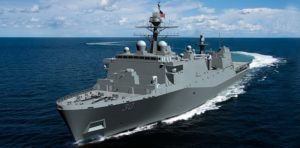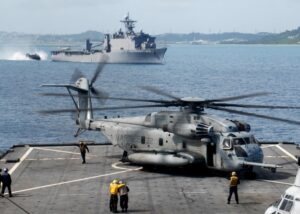Two members on the Senate Armed Services Committee’s (SASC) Seapower panel sent a letter to the Secretary of the Navy on Nov. 15 urging him to provide to Congress the overdue results of an amphibious warship study.
“During your annual force posture hearing in May, we asked about the status of a study you commissioned to analyze the number of amphibious ships needed in our Navy fleet. You told us that the study would be released ‘in the next several weeks.’ It has now been over five months since that hearing, yet the results of the study still have not been provided to either of us,” Sens. Tim Kaine (D-Va.) and Roger Wicker (R-Miss.), members of the SASC Seapower subcommittee, wrote in a letter to Secretary Carlos Del Toro.

(Image: Huntington Ingalls Industries)
The senators “urge you to provide the unredacted, unedited results of the study without further delay. If the study is still incomplete, please provide a reason as to why it is incomplete, whether you need any additional resources to complete the study, and when you expect it to be completed, as well as the results upon completion.”
Marine Corps officials have maintained the service’s requirement for amphibious ships is 31, even while the Navy’s fiscal year 2023 budget request and long-term shipbuilding plan projects dropping to 24 amphibious ships by FY ‘24 due to early retirements. The Navy’s plans include retiring 10 older Whidbey Island/Harpers Ferry (LSD-41/49) classes between three and 14 years earlier than planned and halting construction of the San Antonipo-class Flight II LPD ships after LPD-32.
The Navy’s FY ‘23 budget request also pushed back procurement of the first Light Amphibious Warship to FY ‘25.
The Marine Corps has said its 31 amphibious ship requirement is divided into 10 large deck amphibious assault ships (LHAs) and 21 dock landing ships (LSDs) or amphibious transport dock ships (LPDs).
In the letter, the senators note that “the Navy currently plans to decommission over 40 ships in Fiscal Years 2023 and 2024. As Congress works to fill these gaps and expand our fleet, this study on amphibious ships would provide the Committee with critical context as to the Navy and Marine Corps’ needs.”
If the Navy’s plans go forward, the amphibious force would not get back to 31 ships until at least 2030, depending on which of the three alternatives is followed in the shipbuilding plan.
In May, Lt. Gen. Karsten Heckl, Deputy Commandant of the Marine Corps for Combat Development and Integration, warned the House Armed Services Seapower subcommittee that if the service falls to 24 amphibious ships it can provide “adequate capability” in the Indo-Pacific region but will “be forced to take risk in EUCOM, AFRICOM and CENCOM, there’s no two ways around it,” (Defense Daily, May 19).
Notably, the Marine Corps’ top item on its FY ‘23 unfunded priorities list was $250 million to start working on LPD-33, going against the Navy’s plans (Defense Daily, April 1).

Ultimately, the Senate bill included the $250 million for LPD-33 and set a floor of 31 amphibious ships for the Navy(Defense Daily, Aug. 1), matching the House bill (Defense Daily, June 7).
Kaine and Wicker argued amphibious warships are an important element to naval forces in the Pacific region as the Chinese people’s Liberation Army Navy (PLAN) already has more ships than the U.S. Navy overall “and is on track to reach more than 450 ships by the end of the decade. Furthermore, our most senior admirals and theater commanders have cited the odds of a Chinese advance on Taiwan sharply increasing by 2027.”
“Amphibious warships are a crucial element of our fleet forces in the Pacific, as they bring unique sea-to-shore capabilities to the fight. Failure to provide and maintain a credible naval deterrent today could mean global catastrophe tomorrow,” they added.
Last month, the White House Office of Management and Budget (OMB) published a Statement of Administration Policy arguing against the provisions in the Senate bill that would set the 31 amphibious ships minimum and prohibit the service from retiring 12 ships earlier than planned, including four dock landing ships and two expeditionary transfer dock ships (Defense Daily, Oct. 24).
“Requiring the Department to maintain a minimum inventory of major platforms would limit the Secretary of Defense’s ability to optimize future force structure, increase the long-term cost of sustaining the force, and further delay necessary efforts to keep pace with the challenge posed by the People’s Republic of China in key warfighting areas,” the White House said.